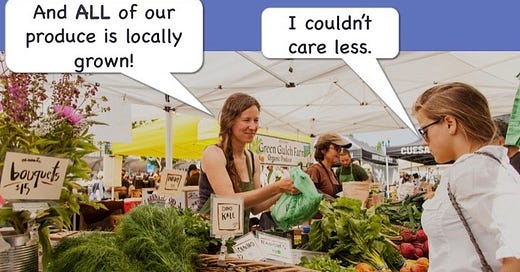Online and even some in-person feedback from the recent Green Dispatch survey indicated that folks want to read about practical things that can lead to more environmentally friendly living. This is the first of “Science you can use” that hopefully can help you be green.
Tackling climate change is the stuff of policy, laws, and treaties. It’s a macro problem and needs macro solutions. Countries need to decarbonize their electric grids, provide more and better public transportation, and a lot of other macro stuff to keep the planet cool.
It also helps if folks make choices to bring down the size of their carbon footprint. A lot of folks already use LED light bulbs, drive hybrid cars, or maybe even get around by biking or using public transportation.
Some have chosen to become locavores, consuming foods grown, harvested, or hunted close to where they live, usually within a radius of 100 miles or so. This food awareness movement came about when, in 2003, researchers at Iowa State University found that, on average, the food we Americans eat travels 1,500 miles from farm to plate. It’s as though every time I order out for pizza, instead of calling up Mazara’s a few blocks from my apartment in San Diego, I dial up Cupini’s in Kansas City, Missouri.
Apples are shipped from Oregon; potatoes come from Idaho; other produce may be shipped from several states away.
A number of food producers and restaurants market themselves as local. About 15 years ago, when the eat-local movement started gaining steam, my wife and I dined at a restaurant that marketed itself as serving local food. It was delightful. The locally raised beef was tops, and I enjoyed the wine from a nearby winery.
While it can be appealing to know that the corn on the cob you are chomping on came from that beautiful farm you drive by from time to time, here is the environmental caveat: there is little evidence that eating local reduces the carbon footprint of your diet. Yes, believe it or not, you don’t have to eat locally to save the planet. Of the dozens of things you can feel guilty about, buying food from afar is not one of them.
Modern agriculture accounts for 10 percent of the greenhouse gases in the United States. Keep in mind that most of that comes from livestock production and poorly managed soils, and only a small portion of agricultural greenhouse gases are produced from transportation. While most conventionally grown produce travels almost 1,500 miles from farm to market, locally grown produce travels an average of 56 miles for the same purpose.
At first glance it seems to make sense that the amount of CO2 released into the atmosphere by transporting a sack of potatoes 56 miles would obviously be less than transporting it 1,500 miles.
But there are a lot of ways to get rutabagas and kohlrabi from here to there. And different means of transportation have different fuel efficiencies. In an Iowa State University study from 2003, researchers found that the semitrailer trucks favored by large agribusiness carried produce pound-for-pound six times more efficiently than the midsize trucks that are mostly used for local agriculture. The Kroger or Publix grocery stores that ship potatoes on a semitrailer 300 miles to your local store use less fuel per pound of potatoes than the organic farmer who uses his pickup to take his wares 60 miles to the neighborhood farmers’ market.
Food is also shipped by rail and cargo ships, which are even more efficient than semitrailer trucks. The same amount of fuel that can transport five pounds of food one mile by personal car can transport that same food 43 miles by air, 740 miles by semitrailer, 2,400 miles by rail, and 3,800 miles by cargo ship.
What this means is if a tomato grown in California’s Central Valley is shipped by train across the country, the CO2 released by that transportation would be less than if you drove four miles to your local Whole Foods to pick it up for dinner.
So if you want to do the planet a favor, walk to the grocery store, or stop by on your way home from work. There is also some evidence that ordering your groceries online and having them delivered lowers your carbon footprint because home delivery reduces the number of cars on the road. The greenhouse gas emissions go up, if refrigeration is used in the delivery.
Now a lot of the folks who grow local food are fine people. And most of the ones who market themselves as local usually practice good agricultural stewardship by being organic or practicing regenerative farming. So if you want to support those folks for those reasons, I’m all for it. But you don’t have to be a locavore. We have enough things to worry about already. So go ahead and buy those peaches from Peru; grab those oranges from Uruguay. Cantaloupe from Costa Rica? No problem! As far as where your food comes from, don’t worry!
For more environmental news follow me on Twitter @EcoScripsit.






Well, I enjoy vegetables from my garden, some of the herbs I have are cilantro, mint, and Italian thyme. But my cousin cleared her garden last Friday, and I’m still eating the vegetables she gave me. It’s Tuesday here in New Zealand.
It’s nice to know I don’t need to feel bad about my banana intake. I will say that I haven’t found anything that beats Ohio corn!